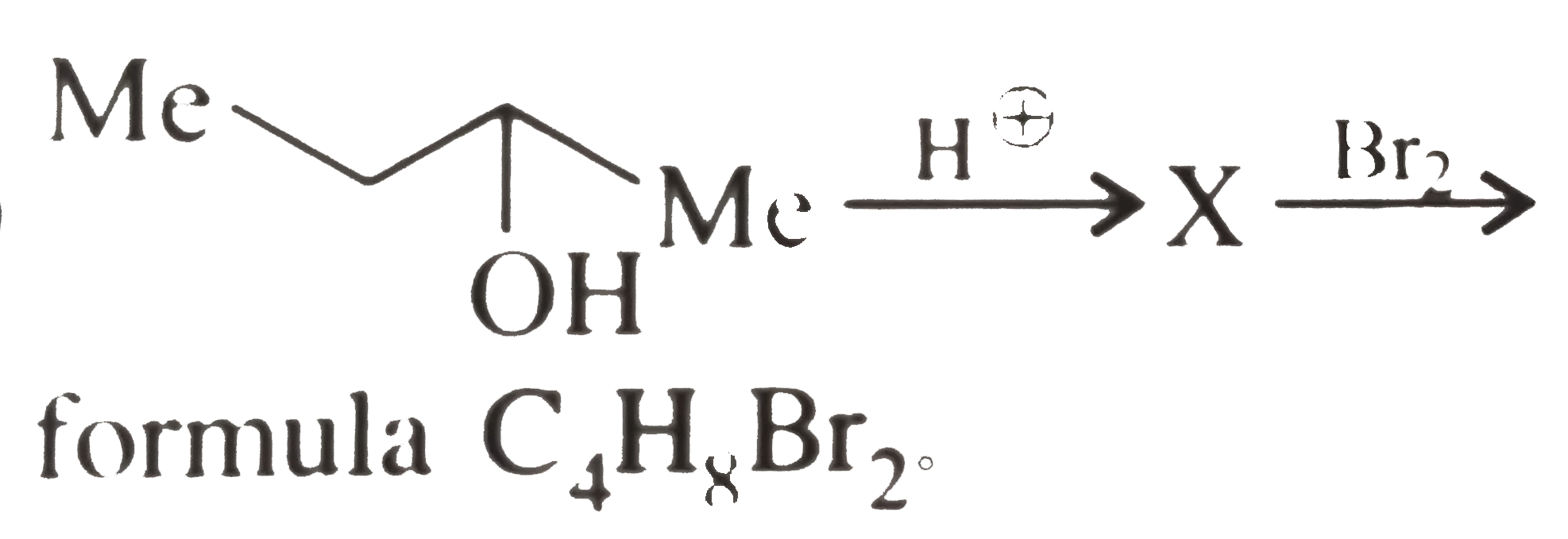There are four alky1 chlorides with the formula C4H9CI. Writre their structures and identify then as 1∘,2∘, and 3∘ alky1 chlorides
To solve the problem of identifying the four alkyl chlorides with the formula C₄H₉Cl and classifying them as primary, secondary, or tertiary, we will follow these steps:
Step 1: Determine the possible structures for C₄H₉Cl
We know that the molecular formula C₄H₉Cl indicates that there are 4 carbon atoms, 9 hydrogen atoms, and 1 chlorine atom. We can create different structural isomers by varying the position of the chlorine atom.
Step 2: Draw the structures
1. 1-Chlorobutane (Primary Alkyl Chloride):
- Structure: CH₃-CH₂-CH₂-CH₂Cl
- Here, the chlorine is attached to the terminal carbon (1st carbon).
2. 2-Chlorobutane (Secondary Alkyl Chloride):
- Structure: CH₃-CHCl-CH₂-CH₃
- In this case, the chlorine is attached to the second carbon, which is connected to two other carbon atoms.
3. 1-Chloro-2-methylpropane (Primary Alkyl Chloride):
- Structure: CH₃-CH(CH₃)-CH₂Cl
- Here, the chlorine is attached to a terminal carbon, making it a primary alkyl chloride.
4. 2-Chloro-2-methylpropane (Tertiary Alkyl Chloride):
- Structure: (CH₃)₃CCl
- In this structure, the chlorine is attached to a carbon that is connected to three other carbon atoms, making it a tertiary alkyl chloride.
Step 3: Classify the alkyl chlorides
- Primary Alkyl Chlorides:
- 1-Chlorobutane
- 1-Chloro-2-methylpropane
- Secondary Alkyl Chloride:
- 2-Chlorobutane
- Tertiary Alkyl Chloride:
- 2-Chloro-2-methylpropane
Final Summary of Structures:
1. 1-Chlorobutane: CH₃-CH₂-CH₂-CH₂Cl (Primary)
2. 2-Chlorobutane: CH₃-CHCl-CH₂-CH₃ (Secondary)
3. 1-Chloro-2-methylpropane: CH₃-CH(CH₃)-CH₂Cl (Primary)
4. 2-Chloro-2-methylpropane: (CH₃)₃CCl (Tertiary)
We know that the molecular formula C₄H₉Cl indicates that there are 4 carbon atoms, 9 hydrogen atoms, and 1 chlorine atom. We can create different structural isomers by varying the position of the chlorine atom.
1. 1-Chlorobutane (Primary Alkyl Chloride):
- Structure: CH₃-CH₂-CH₂-CH₂Cl
- Here, the chlorine is attached to the terminal carbon (1st carbon).
- Structure: CH₃-CHCl-CH₂-CH₃
- In this case, the chlorine is attached to the second carbon, which is connected to two other carbon atoms.
- Structure: CH₃-CH(CH₃)-CH₂Cl
- Here, the chlorine is attached to a terminal carbon, making it a primary alkyl chloride.
- Structure: (CH₃)₃CCl
- In this structure, the chlorine is attached to a carbon that is connected to three other carbon atoms, making it a tertiary alkyl chloride.
- Primary Alkyl Chlorides:
- 1-Chlorobutane
- 1-Chloro-2-methylpropane
- Secondary Alkyl Chloride:
- 2-Chlorobutane
- Tertiary Alkyl Chloride:
- 2-Chloro-2-methylpropane
1. 1-Chlorobutane: CH₃-CH₂-CH₂-CH₂Cl (Primary)
2. 2-Chlorobutane: CH₃-CHCl-CH₂-CH₃ (Secondary)
3. 1-Chloro-2-methylpropane: CH₃-CH(CH₃)-CH₂Cl (Primary)
4. 2-Chloro-2-methylpropane: (CH₃)₃CCl (Tertiary)
Topper's Solved these Questions
- CLASSIFICATION AND NOMENCLATURE OF ORGANIC COMPOUNDSBOOK - CENGAGE CHEMISTRY ENGLISHCHAPTER - CLASSIFICATION AND NOMENCLATURE OF ORGANIC COMPOUNDSEXERCISE - Concept Application Type
7 Videos
- CLASSIFICATION AND NOMENCLATURE OF ORGANIC COMPOUNDSBOOK - CENGAGE CHEMISTRY ENGLISHCHAPTER - CLASSIFICATION AND NOMENCLATURE OF ORGANIC COMPOUNDSEXERCISE - Linked Comprehesion Type
12 Videos
- CLASSIFICATION AND NOMENCLATURE OF ORGANIC COMPOUNDSBOOK - CENGAGE CHEMISTRY ENGLISHCHAPTER - CLASSIFICATION AND NOMENCLATURE OF ORGANIC COMPOUNDSEXERCISE - Solved Example
5 Videos
- CHEMICAL EQUILIBRIUMBOOK - CENGAGE CHEMISTRY ENGLISHCHAPTER - CHEMICAL EQUILIBRIUMEXERCISE - Subjective type
1 Videos
- GENERAL ORGANIC CHEMISTRYBOOK - CENGAGE CHEMISTRY ENGLISHCHAPTER - GENERAL ORGANIC CHEMISTRYEXERCISE - Analytical and Descriptive
1 Videos
Similar Questions
There are seven isomeric compounds with the formula C4H10O Write their structures and identify their functional groups
View SolutionThere are four amides with the formula C3H7NO.
Write their structures.
Identify the amide which has lower melting point and boiling point than the other three.
View SolutionThe number of isomeric amines possible for the formula C3H9N
View SolutionWrite the isomers of the compound having formula C4H9Br.
View SolutionWrite the structural formula for seven compounds with the formula C3H6O and identify the funcitonal groups.
View SolutionDraw all structurally isomeric 2∘ chlorides with molecular formula C5H11Cl
View Solutionwrite the structural formula for each of the following
a. A 3∘ amine with the formula C3H9N.
b. Three ethers with the formula C4H10O.
c. A 3∘ alcohol with the formula C4H8O.
View Solution
Find compound with formula C4H8Br2
How many structure of (X) are possible?
View Solution_E01_079_Q01.png)
Write structure of C4H9Cl.
View SolutionAn alkyl halide having molecular formula C4H9Cl is optically active. What is its structure?
View Solution
